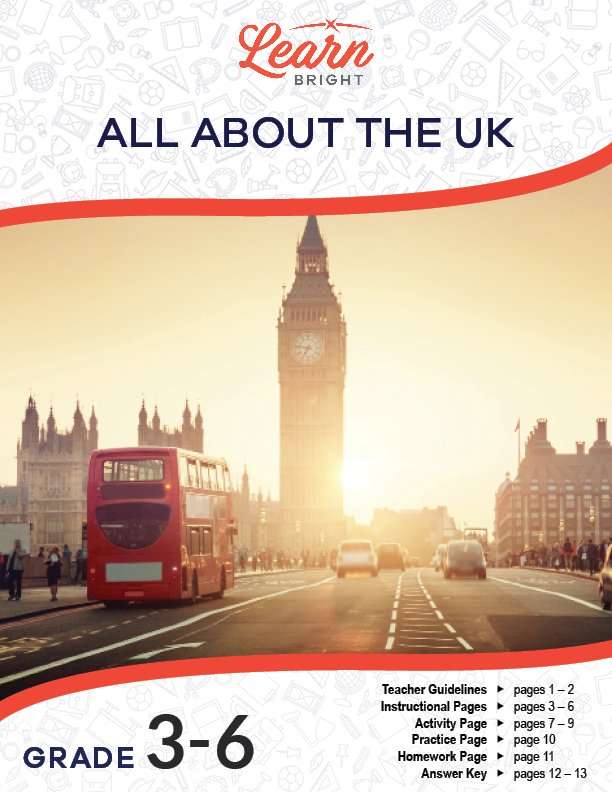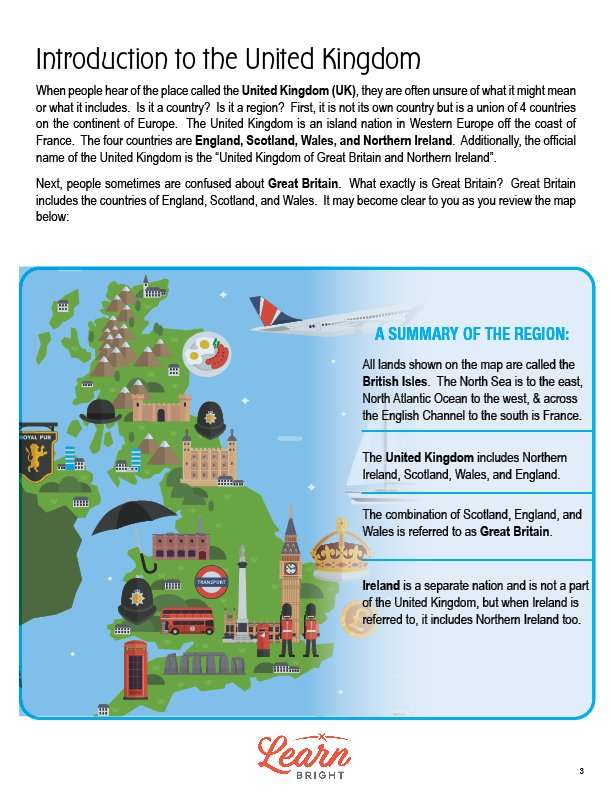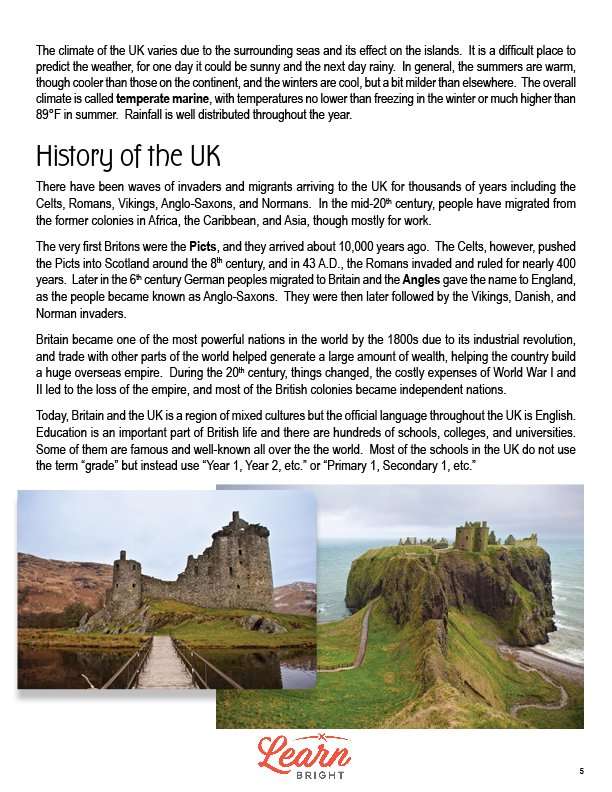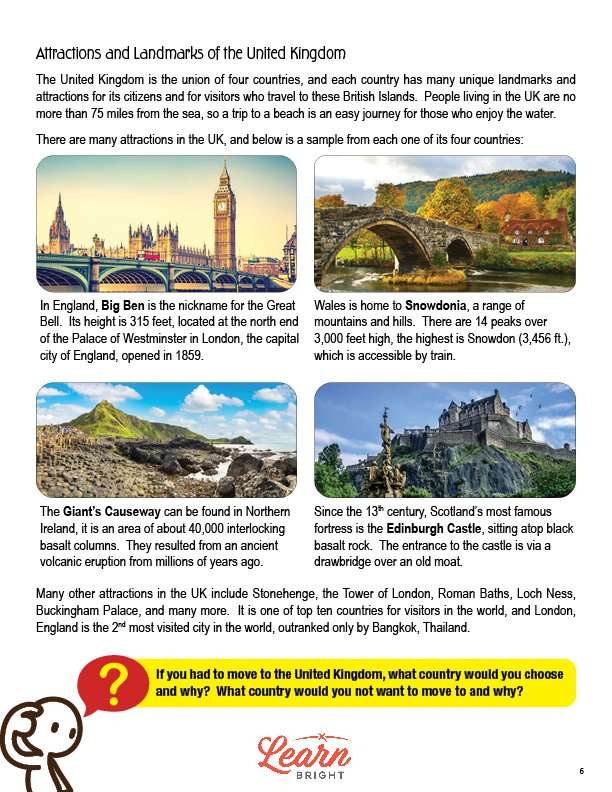Description
What our All About the UK lesson plan includes
Lesson Objectives and Overview: All About the UK introduces students to the United Kingdom. At the very beginning, the lesson addresses the confusion between the UK and England, listing all the countries that belong to each the UK and Great Britain along with a map to enhance understanding. The lesson includes some major landmarks and attractions, like the English Channel, Thames River, and the Edinburgh Castle. At the end of the lesson, students will be able to locate the United Kingdom (UK) on a map, list some characteristics and facts about the region, and explain some of its history. This lesson is for students in 3rd grade, 4th grade, 5th grade, and 6th grade.
Classroom Procedure
Every lesson plan provides you with a classroom procedure page that outlines a step-by-step guide to follow. You do not have to follow the guide exactly. The guide helps you organize the lesson and details when to hand out worksheets. It also lists information in the orange box that you might find useful. You will find the lesson objectives, state standards, and number of class sessions the lesson should take to complete in this area. In addition, it describes the supplies you will need as well as what and how you need to prepare beforehand. You will need colored pencils and the handouts for this lesson. To prepare for this lesson ahead of time, you can find a map for the lesson, pair students for the activity, gather the supplies, and copy the handouts.
Options for Lesson
Included with this lesson is an “Options for Lesson” section that lists a number of suggestions for activities to add to the lesson or substitutions for the ones already in the lesson. One optional addition to this lesson is to assign a country to each student to do additional research on. You can also have your students create a booklet that contains information about each country, including images of their flags. You could invite someone who’s been to the UK to speak to your class about what that was like. Another fun addition could be to plan a “UK Day” for the class. You could assign a landmark or attraction to each student to research. Finally, students can write an essay that describes the day to day life of someone living in the UK.
Teacher Notes
The teacher notes page includes a paragraph with additional guidelines and things to think about as you begin to plan your lesson. This page also includes lines that you can use to add your own notes as you’re preparing for this lesson.
ALL ABOUT THE UK LESSON PLAN CONTENT PAGES
Introduction to the United Kingdom
The All About the UK lesson plan includes four content pages. The lesson begins by stating that many people are confused about what the United Kingdom includes. The United Kingdom is not a country, but a union of four different countries in Europe. England, Scotland, Wales, and Northern Ireland make up the United Kingdom. The official name is the United Kingdom of Great Britain and Northern Ireland. Great Britain is England, Scotland, and Wales. We call the whole region the British Isles, with the North Sea to the east, the Atlantic Ocean to the west, and the English Channel to the south. It’s important to note that Ireland is a separate nation and is not part of the United Kingdom. However, when we speak about Ireland, we mean Ireland and Northern Ireland together.
The UK is 93,628 square miles and has 65 million people total. England is the most populous of the four countries with 53 million people (84% of the total population). Northern Ireland is the least populous with 1.8 million people. The most populous city in the UK is London, England, with almost 9 million people. Because of this, people sometimes call London the capital of Britain.
You can find high ground and mountain ridges separated by deep valleys in the north and west regions of the UK. Glaciers from the last Ice Age shaped these valleys. In the south, you mostly find rolling hills. Northwest England and the Scottish Highlands have dozens of lakes, which they call lochs. Melting glaciers left behind these lochs long ago, and they’re long, narrow, and deep. Loch Ness, a lake in Scotland, is where the legend of the Loch Ness Monster comes from.
The Cumbrian Mountains, Hebrides Islands, Shetland Islands, and Highland Boundary Fault are all major landforms in the UK. The Scottish Highlands, another significant landform, are rugged mountains that humans have mostly left alone. In Britain, they use around three quarters of all the land for farming.
Bodies of Water
The English Channel separates the UK from France and links the North Sea to the Atlantic Ocean. The Channel is 350 miles long, with the shortest width 21 miles across and the longest widths 150 miles across. People sometimes try to swim across the channel.
Some other major bodies of water in the UK include the longest river in England, the Thames River; the longest river in the UK, the Severn River; and the Humber River. Lough Neagh and Lower Lough Erne are the two largest lakes, and both are located in Northern Ireland. Some other lakes includes Loch Lomond in Scotland, Lake Bala in Wales, and Lake Windermere in England.
Because of the various seas surrounding England, the climate varies. This means that it can be hard to predict the weather. Summers tend to be warm and winters tend to be cool but mild. We call this a temperate marine climate. Temperatures don’t generally go below freezing in the winter or higher than 89 degrees Fahrenheit in the summer. It rains throughout the year.
History of the UK
The UK has seen waves of invaders and migrants throughout its history, like the Celts, Romans, Vikings, Anglo-Saxons, and Normans. More recently, in the mid-20th century, people migrated for work from former colonies in Africa, the Caribbean, and Asia.
The Picts were the first Britons. They arrived about 10,000 years ago. In the 8th century, the Celts pushed the Picts into Scotland. In 43 A.D., the Romans took over and ruled for about 400 years. Later, in the late 6th century, German people by the name of Angles migrated to Britain. This is where we get the name Anglo-Saxon from. The Vikings, Danish, and Norman invaders came later.
By the 1800s, Britain was one of the most powerful nations in the whole word because of the industrial revolution and their trade with other parts of the world. They built a large overseas empire with their large amounts of wealth. Following World War I and World War II, they lost some of their empire, and many British colonies gained their independence.
Britain and the UK today have many different peoples and cultures, though their official language is still English. They care about education and have hundreds of schools and universities. Some of their schools are very famous. They also use the terms “Year 1,” “Year 2,” and on instead of saying “grade” at school.
Attractions and Landmarks of the United Kingdom
This lesson closes by describing some notable attractions in the United Kingdom. Each of the four countries in the UK have unique landmarks and attractions for their citizens and visitors. If you live in the UK, you’re no more than 75 miles from the sea, so you can always visit the beach.
The lesson lists four attractions, each of which is from a different country in the UK: Big Ben, the Great Bell in England that opened in 1859, is 315 feet tall, and is located on the north side of the Palace of Westminster in London; Snowdonia, a range of mountains and hills in Wales that has 14 peaks over 3,000 feet high, the highest of which is Snowdon at 3,456 feet; Giant’s Causeway, an area of 40,000 interlocking basalt columns in Northern Ireland that formed due to volcanic eruptions million of years ago; and Edinburgh Castle, the most famous fortress in Scotland since the 13th century, which sits on top of black basalt rock.
Some other attractions in the UK include Stonehenge, the Tower of London, Roman Baths, Loch Ness, Buckingham Palace, and more. The UK is in the top ten countries for visitors in the world, with London, England as the second most visited city in the world (after Bangkok, Thailand).
Key Terms
Here is a list of the vocabulary words students will learn in this lesson plan:
- Great Britain: Includes the countries of England, Scotland, and Wales
- British Isles: All of the countries in this region
- English Channel: Links the North Sea to the Atlantic Ocean
- Thames River: The longest river in England
- Severn River: The longest river in the UK
- Lough Neagh: The largest lake in the UK, located in Northern Ireland
- Temperate marine: The climate of the UK
- Picts: The first Britons
- Big Ben: The Great Bell in England
- Snowdonia: A range of mountains and hills in Wales
- Giant’s Causeway: An area of 40,000 interlocking basalt columns in Northern Ireland
- Edinburgh Castle: Scotland’s most famous fortress
ALL ABOUT THE UK LESSON PLAN WORKSHEETS
The All About the UK lesson plan includes three worksheets: an activity worksheet, a practice worksheet, and a homework assignment. You can refer to the guide on the classroom procedure page to determine when to hand out each worksheet.
RESEARCH PROJECT ACTIVITY WORKSHEET
Students will work with a partner to complete the lesson activity. Each pair will complete a research project where they research the four countries of the UK. They’ll use the internet to help them find the information that they need. They will use the activity map to identify, locate, draw, and label the outline of each country, the capital cities, the bodies of water, the mountains, the rivers, two additional cities in each country, and the English Channel. They will also do some additional research on one of the countries, where they research a list of things like the population and land area statistics, the religions practiced in the country, some popular attractions and landmarks, and more. Students can find the full list of things they need to research on the activity worksheet. Once they finish their project, they will share what they discovered with the rest of the class.
Students can also work either alone or in groups if you’d prefer.
LISTING COUNTRIES PRACTICE WORKSHEET
For the practice worksheet, students will complete two exercises. For the first, they will list the countries of the British Isles, Great Britain, the United Kingdom, and the Island of Ireland. And for the second, they will answer 15 questions about the United Kingdom that they learned about during the lesson.
ALL ABOUT THE UK HOMEWORK ASSIGNMENT
The homework assignment asks students to first name five attractions that the worksheet describes. Next, they will read ten statements and will determine whether they’re true or false. Finally, they will write a short paragraph of what they would say to someone who is confused about the UK, Britain, and England.
Worksheet Answer Keys
This lesson plan includes answer keys for the practice worksheet and the homework assignment. If you choose to administer the lesson pages to your students via PDF, you will need to save a new file that omits these pages. Otherwise, you can simply print out the applicable pages and keep these as reference for yourself when grading assignments.











